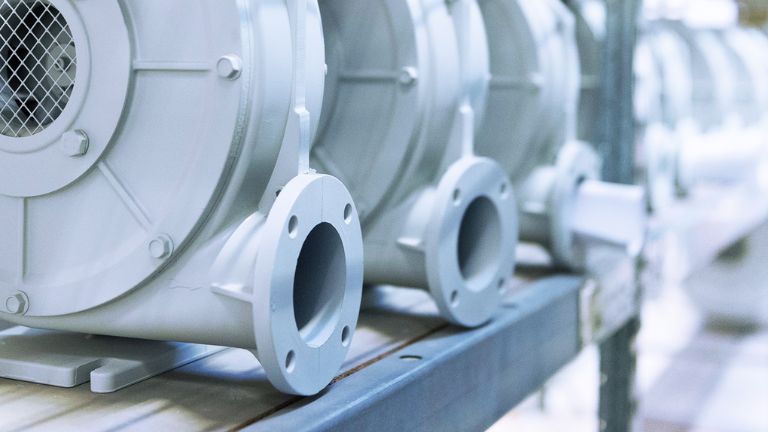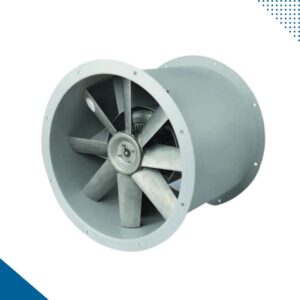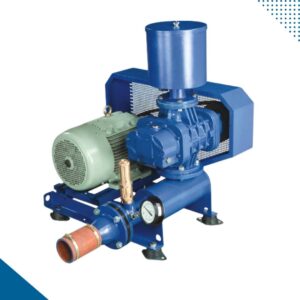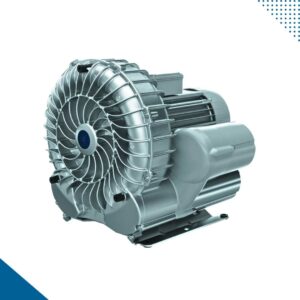What is a Blower
What is a Blower?
Pneumatic conveying systems play a crucial role in moving bulk materials such as powder, pellets, granules, grains, spices, etc., through enclosed pipelines using gas, commonly air or nitrogen. These systems, having applications across various industries, utilize gas pressure differential and flow to transport granular or powder materials. This article delves into the diverse blowers used in pneumatic conveying systems, exploring their working principles covering selection criteria.
What is a Blower?
A blower is a mechanical device that generates a flow of air or gas, typically for the purpose of moving or circulating air in various applications. Blowers are commonly used in HVAC (Heating, Ventilation, and Air Conditioning) systems, pneumatic conveying systems, water or effluent treatment, industrial processes, and various other settings where the movement of air or gas is required. They come in different types and sizes to suit specific applications.

Blower Types and Working Principles:
Blowers come in various types and subtypes, each designed for specific applications and operating conditions. The working principle of a blower involves converting mechanical energy, usually provided by an electric motor or engine, into kinetic energy and then into pressure energy. The type of blower, whether centrifugal, axial, positive displacement, or regenerative, determines the specific mechanism by which this conversion occurs.
1. Centrifugal Blower :
- Also known as radial fans or centrifugal fans
- These blowers use a rotating impeller to create a centrifugal force that accelerates the air or gas outward from the center of the device
- Centrifugal blowers are often used in HVAC systems, industrial ventilation, and air pollution control
- The types include forward-curved centrifugal blowers, backward-curved centrifugal blowers, radial blowers, compact centrifugal blowers, high temperature centrifugal blowers, corrosion resistant centrifugal blowers, high pressure blowers, multistage centrifugal blower

Working Principle :
- Impeller Rotation: The blower has an impeller with blades that rotates within a casing.
- Air Intake: Air or gas enters the blower through an inlet.
- Centrifugal Force: The rotating impeller imparts centrifugal force to the incoming air, causing it to move radially outward.
- Diffusion: The outward-moving air then enters a diffuser, which slows down the air and converts kinetic energy into pressure energy.
- Air Discharge: The air is discharged from the blower at an increased pressure and velocity.
2. Axial Blower :
- Also known as axial fans
- Axial blowers move air parallel to the axis of the impeller
- They are commonly used for applications such as cooling electronic equipment, providing ventilation in confined spaces, and cooling industrial processes

Working Principle :
- Impeller Rotation: Axial blowers have an impeller that rotates around an axis parallel to the direction of the airflow.
- Air Intake: Air enters axially, parallel to the axis of rotation.
- Axial Flow: The impeller propels the air in a straight-through direction.
- Air Discharge: The air exits the blower in the same axial direction.
3. Positive Displacement Blowers :
- Also known as rotary lobe blowers or rotary piston blowers.
- These blowers utilize positive displacement to move air or gas.
- Positive displacement blowers are often used in applications such as pneumatic conveying, wastewater treatment, and aeration in water treatment plants.

Working Principle :
- Lobe or Screw Movement: Positive displacement blowers use rotating lobes or screws to trap and move a fixed volume of air or gas with each revolution.
- Air Compression: As the lobes or screws rotate, they create pockets of air, compressing and displacing it through the blower.
4. Regenerative Blowers :
- Also known as side channel or ring channel blowers.
- These blowers use the regenerative principle to create air flow.
- They are often used in applications requiring low flow rates and moderate pressure, such as vacuum packaging, vacuum lifting and pneumatic conveying.
- The types include single stage regenerative blowers, multistage regenerative blowers

Working Principle :
- Impeller Spin: Regenerative blowers have an impeller with multiple blades that spin rapidly.
- Regenerative Action: The spinning impeller generates airflow by pushing air outward to the housing walls, creating a regenerative effect.
- Continuous Movement: The regenerative process contributes to the continuous movement of air.
5. Multistage Blowers :
- Also known as side channel or ring channel blowers.
- These blowers use the regenerative principle to create air flow.
- They are often used in applications requiring low flow rates and moderate pressure, such as vacuum packaging, vacuum lifting and pneumatic conveying.
- The types include single stage regenerative blowers, multistage regenerative blowers
Selection criteria for Blower
Selecting the right blower for a specific application involves considering various factors to ensure optimal performance and efficiency. Here are key criteria for blower selection:
Airflow Requirements:
- Determine the required volume of air (in cubic feet per minute or cubic meters per second) for the application.
- Consider the variations in airflow demand and whether the blower needs to operate at a constant or variable speed.
- Key parameters considered for calculating airflow requirements are conveying capacity, distance & number of bends in conveying line.
Pressure Requirements:
- Identify the system’s pressure needs, usually expressed in mm of water column (mmWC) or pascals.
- Consider both static pressure (resistance to flow) and dynamic pressure (velocity of the air).
Temperature Considerations:
- Evaluate the temperature of the air or gas being handled by the blower.
- Choose a blower that can operate effectively within the specified temperature range.
Altitude & Atmospheric Conditions:
- Account for the altitude at which the blower will operate, as this affects the air density.
- Consider the humidity and other atmospheric conditions that might impact blower performance.
Application Type:
- Different applications like dilute phase/dense phase pneumatic conveying, etc. require specific types of blowers (e.g., centrifugal, axial, positive displacement).
- Consider whether the blower is needed for ventilation, material handling, pneumatic conveying, aeration, or other purposes.
Efficiency & Energy Consumption:
- Evaluate the blower’s efficiency to ensure it meets energy efficiency standards.
- Consider the total cost of ownership, including energy consumption and maintenance costs.
- Choose a blower with a capacity, matching usual requirements, add a factor of safety for demand variations, and avoid overcapacity to optimize energy consumption in pneumatic conveying systems.
Operating Speed & Control:
- Determine the required operating speed and consider if variable speed control is necessary for the application.
- Variable speed control can optimize energy efficiency by matching the blower’s speed to the actual demand.
Noise Level:
- Assess the noise level produced by the blower and ensure it complies with the acceptable noise standards for the application.
- General criteria for acceptance of noise level: Noise Level < 85dB
- Silencers, Acoustic Covers are used to reduce noise level.
Space Constraints:
- Consider the available space for installing the blower.
- Choose a blower that fits within the available footprint while allowing for proper ventilation and maintenance access.
Material Compatibility:
- Verify that the blower materials are compatible with the handled air or gas, especially if it contains corrosive or abrasive elements.
Reliability & Maintenance:
- Evaluate the blower’s reliability and ease of maintenance.
- Choose a blower with a track record of reliability and one that is easy to access for routine maintenance tasks.
Budgetary Constraints:
- Consider budget constraints and choose a blower that offers the best balance of performance and cost-effectiveness.
By carefully considering these criteria, engineers and system designers can select a blower that meets the specific needs of the application, ensuring efficient and reliable operation over time. For pneumatic conveying systems, the design criteria are crucial to the performance of the system, as the parameters are directly proportional to the right selection. Get in touch with subject matter experts at Indpro to know more about these selection criteria.



